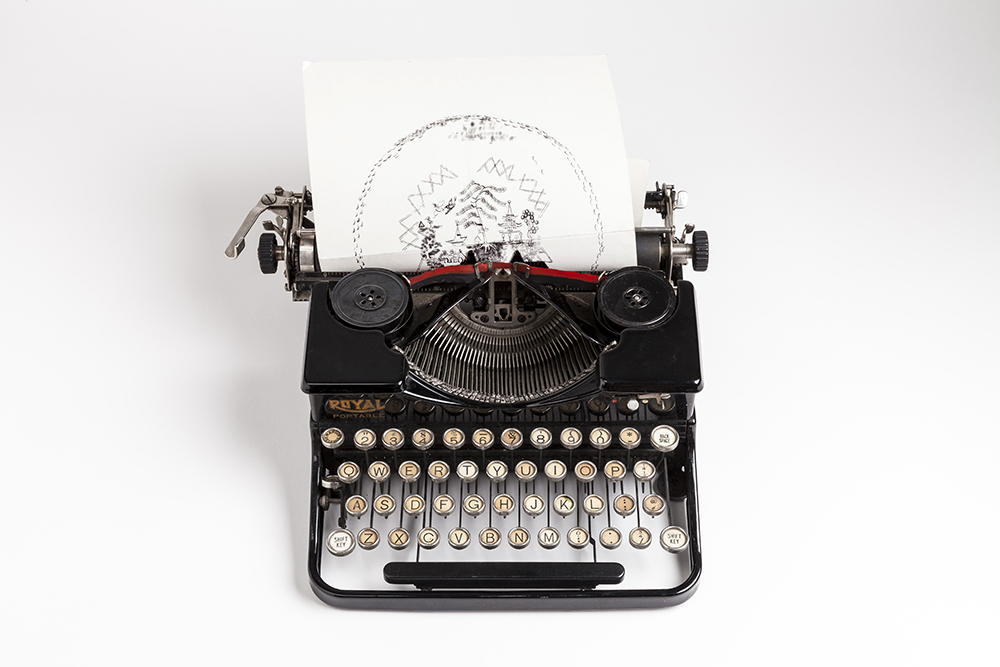For Immediate Release: February 6, 2017
Press Preview: Thursday, March 16, 1:00 – 3:00 pm
Press Contact: Jan Rothschild, +1.215.983.2157, jan@janrothschild.com
THE FABRIC WORKSHOP AND MUSEUM PRESENTS
OBJECT TEMPORARILY REMOVED
An Exhibition by Lenka Clayton
On view March 17, 2017 to July 9, 2017
Exhibition includes two new works made in collaboration with The Fabric Workshop and Museum including 17 new Sculptures for the Blind, made by blind artists, a collection of contemporary replies to a 40 year-old unanswered letter as well as a small survey of recent projects.
Tweet This: .@FabricWorkshop presents new works by #LenkaClayton made in response to Brancusi’s Sculpture for the Blind: http://ow.ly/9HOe307PslB
Philadelphia—Beginning March 17, 2017, The Fabric Workshop and Museum (FWM) presents Object Temporarily Removed, an exhibition by Lenka Clayton including two new works; Sculpture for the Blind, by the Blind and Unanswered Letter, created during her recent artist residency at The Fabric Workshop. The new work responds to a 1920 sculpture by Constantin Brancusi, Sculpture for the Blind, in the permanent collection of the Philadelphia Museum of Art. On view concurrently, and opening to the public on February 10, 2017, is a small survey of works by Clayton made since 2012, selected by Susan Talbott, executive director of FWM. Clayton is a British-born artist based in Pittsburgh whose work transforms and subverts pre-existing ideas or norms to create artworks that challenge and expand our perceptions of the everyday.
“Lenka’s investigation of Sculpture for the Blind in Philadelphia has revealed and expanded that work in extraordinary ways,” said Talbott. “Sculpture for the Blind, by the Blind proposes to take literally Brancusi’s title, resulting in a collaboration with members of Philadelphia’s blind and visually impaired communities, whose interpretations of Brancusi’s iconic form are profoundly tender and poetic.”
In Sculpture for the Blind, by the Blind, Clayton was inspired by the seemingly incompatible combination of the sculpture’s title and its museum display inside a glass case where it cannot be touched and is thereby only available to the sighted. Clayton and the FWM studio explored many options to gain access to the renowned sculpture to try to make it accessible to the blind, but conservation and copyright issues made handling, loaning the work or making a copy impossible. Instead, Clayton invited members of the city’s blind community to make their own sculptures for the blind, carved in white plaster, based only on a verbal description of the Brancusi original. Seventeen blind and visually impaired adults and teenagers took part in two workshops, one held at FWM with artists from Allens Lane Art Center Vision Through Art program, and the other at Overbrook School for the Blind in Philadelphia. These new Sculptures for the Blind are now on display in the FWM galleries, two miles down the road from Brancusi’s original in its glass case.
“What was most exciting about this collaboration was being part of Lenka’s working process,” said FWM Project Coordinator Andrea Landau. “She starts with an idea, puts it to the test, and the work unfolds from there. Lenka wanted to find a way to get Sculpture for the Blind into the hands of people who are blind and then to make the resulting artwork as accessible as possible. The limitations imposed by the inaccessibility of the sculpture pushed her in new and unexpected directions.”
In Unanswered Letter, Clayton invited 1,000 museum directors and curators from around the world to respond to an unanswered letter she discovered in the Philadelphia Museum of Art’s archives. The letter was written in 1978 from a member of the public to Anne D’Harnoncourt, who was then chief curator of the Philadelphia Museum of Art. Referring to Brancusi’s Sculpture for the Blind, the letter asks simple yet poignant questions about how cultural value is constructed around art and artists.
Clayton received more than 165 replies from representatives of international arts institutions large and small including MoMa, the Metropolitan Museum of Art, the Smithsonian Archives, Kunsthalle Zurich and others. This unique collection of contemporary voices in letter form are presented in the FWM galleries, offering insightful, personal and often humorous commentaries on an age-old question for the public to consider and debate.
The presentation of works on display in the ground floor galleries from February 10, 2017-July 9, 2017, explores recurring themes in Clayton’s practice and includes sculpture, video, typewriter drawings, and work from An Artist Residency in Motherhood.
“This part of the exhibition heightens our sense that Clayton’s subversion of the commonplace is based on following logical rules until they become illogical,” said Talbott, who oversaw the selection. “There are shoes that can’t be worn, scissors that can’t cut, drawings made with a typewriter—a machine not designed to draw. The result is absurd and at the same time sharply funny.”
In One Brown Shoe, 100 married couples were invited to each make a single brown shoe from material they found in their homes without conferring or seeing the other’s product, creating inadvertent and poignant portraits of themselves and their partners.
Clayton has worked extensively with the typewriter, using it as a drawing tool, a fabric printer, a sculpture and a mechanism for animation. Several works from this series are on view in the FWM galleries.
An Artist Residency in Motherhood (ARiM) began as a way for Clayton to create a new structure for her own art practice while simultaneously caring for her children. ARiM aims to acknowledge and transform the constraints often experienced by artist/parents such as exhaustion, anxiety, and nap-length studio time into artistic material to work with. On Mother’s Day 2016, she offered ARiM as a self-directed, open-source artist residency to any artist who is also a parent to implement in their own homes and lives as parents. There are currently almost 300 registered Artists-in-Residence-in-Motherhood in 31 countries, on six continents. Read more at: www.artistresidencyinmotherhood.com
About the Funders
Support for Lenka Clayton: Object Temporarily Removed is provided by the National Endowment for the Arts, the Andy Warhol Foundation for the Visual Arts, the Arcadia Foundation, and the Board of Directors and Members of The Fabric Workshop and Museum. FWM receives state arts funding support through a grant from the Pennsylvania Council on the Arts, a state agency funded by the Commonwealth of Pennsylvania and the National Endowment for the Arts, a federal agency.

 Download the Press Release PDF
Download the Press Release PDF